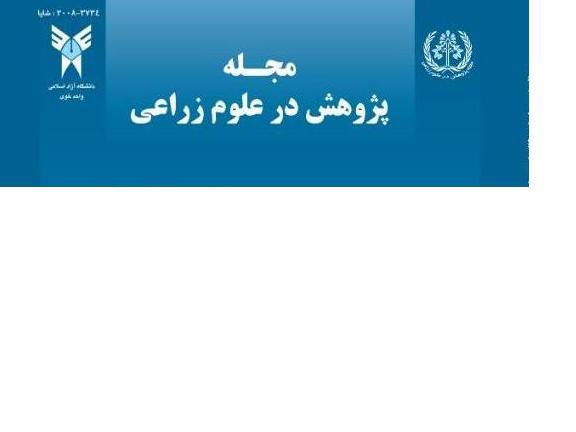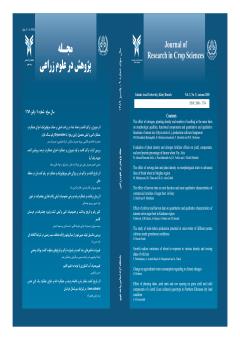تاثير رقم و تاريخ برداشت بر خصوصيات كمي و كيفي كشت پاييزه چغندرقند در شهرستان كاشمر
محورهای موضوعی : توليد محصولات زراعي
1 - دانشگاه آزاد اسلامي، واحد نيشابور، دانشجوي كارشناسي ارشد زراعت، نيشابور، ايران
کلید واژه: چغندرقند پاييزه, درصد قند خالص, ساقه روي , عملكرد قند خالص ,
چکیده مقاله :
به منظور بررسي اثرات رقم و تاريخ برداشت بر خصوصيات كمي و كيفي چغندرقند پاييزه ، آزمايشي در سال زراعي 1389 – 1388 در ايستگاه تحقيقات شهرستان كاشمر انجام شد. اجراي اين طرح بصورت كرت هاي يكبار خرد شده در قالب بلوك هاي كامل تصادفي با چهار تكرار صورت گرفت. كرت هاي اصلي آزمايش شامل چهار رقم (7112 ، SBSI002 ، GIADA و RIZOFORT ) وكرت هاي فرعي شامل سه تاريخ برداشت ( اول ارديبهشت ، بيستم ارديبهشت و دهم خرداد ) بودند. خصوصيات مورد بررسي شامل عملكرد ريشه، ساقه روي ( بولت )، درصد قند ناخالص ، درصد قند خالص، عملكرد قند ناخالص و عملكرد قند خالص براي هر يك ازتاريخ هاي برداشت اندازه گيري گرديد. نتايج نشان داد كه بين ارقام چغندرقند از نظر صفات عملكرد ريشه ، ساقه روي ، درصد قند ناخالص و درصد قند خالص تفاوت بسيار معني داري وجود دارد و رقم GIADA با بيشترين عملكرد ريشه به ميزان 17/49 تن در هكتار و كمترين ميزان ساقه روي مناسب ترين رقم براي منطقه مي باشد. همچنين تاريخ برداشت اثر معني داري بركليه صفات مورد بررسي داشت . اثرات متقابل رقم و تاريخ برداشت در مورد صفت هاي عملكرد ريشه، ساقه روي، درصد قند خالص، درصد قند ناخالص، عملكرد قند خالص و عملكرد قند ناخالص نيز معني دار گرديد. آخرين تاريخ برداشت (دهم خرداد) به دليل حصول بالاترين عملكرد ريشه ، بيشترين درصد قند ناخالص، درصد قند خالص و بيشترين عملكرد قند ناخالص و عملكرد قند خالص، مناسب ترين زمان برداشت چغندرقند پاييزه در منطقه كاشمر مي باشد.
To investigate the effects of cultivar and harvest date on quantitative and qualitative characteristics of autumn sown sugar beet, an experiment was conducted in Kashmar agricultural research station in 1389 - 1388. The experiment was conducted as randomized complete block design with four replications and split plot arrangement. The main plots included four cultivars (7112, SBSI002, GIADA and RIZOFORT) and factors of subplot were three harvest dates (April 20th, May 10th and May 30th). The characteristics included root yield, bolt percentage, sugar content percentage, white sugar content percentage, sugar yield, white sugar yield, for each harvest Dates was measured. Results showed that among varieties of sugar beet, root yield, bolt percentage, sugar content percentage and white sugar content percentage, were different significantly. The Giada was the most suitable cultivar for Kashmar region because of the highest root yield ( 49.17 tons per hectare) and the lowest percent of bolting. All characteristics by harvest date were affected significantly. The interaction effect of cultivar and harvest date were significant on Root yield, Bolt percentage, Sugar content percentage, white sugar content percentage, sugar yield, white sugar yield. For achieving the highest Root yield, Sugar content percentage, white sugar content percentage, sugar yield, white sugar yield, the harvest date of May 30th is recommended for the Kashmar region.
Abdollahian noghabi, M., R. Shakholslami and B. Babaee. 2006. Technological terms and definitions of quantity and quality of sugar beet. Journal of sugar beet,21: 101-104. (In Persian).
Ahmadi, M. 2010. Fall planting of sugar beet production for sustained achievement in Khorasan. 31th Annual Conference of Iranian sugar factories. Research Center newsletter, and sugar industries of Iran, 224: 20-24. (In Persian).
Alimoradi, A., V. Ghadiri., and R. Shakholslami. 1999. Sugar beet from science to practice. ( translate). Publication of Agricultural Sciences. 656 PP. (In Persian).
Basati, J. 2003. Investigate the possibility of autumn sowing of sugar beet in warm regions of Kermanshah. Journal of sugar beet, 18: 119-130. (In Persian).
Basati, J. 2005. The final test report to determine the appropriate time of sowing and autumn harvesting sugar beet in warm areas, Iranian. Published by the Institute of Sugar Beet Research, 57 PP, Pages 5- 20. (In Persian).
Cavaza, L. 1976. Experimental data on the irrigation technique for sugar beet in southern Italy. 39th Winter Congress of International Iinstitude for Sugar Beet. Bruxeles February :347-364.
Ghaemi, A. 2001. Research project on some physiological parameters affecting the performance and quality of sugar beet. Khorasan Research Center for Agricultural Publishing. 40 PP. pages 30-35. (In Persian).
Games. 1997. Bolting of sugar beet. Home Diseases. Holly Sugar Plant Pathology Laboratory. Holly Sugar P. O. Box 60. Tracy, Ca, g5378.
Gordo, L. F. 2004. La calidad tecnologica de la remolacha azucarera.AIMCRA, Artes Graficas, alladolid, Spain. Physiologia Plantarum 124: 200-207.
Javaheri, M. 2003. Investigate the possibility of autumn sowing of sugar beet in the region of Kerman Arzoieh. Jornal of Pagohesh and sazandegee, 71: 85- 93. (In Persian).
Khodabandeh, N. 1988. Agriculture, industrial plants. Publications Press Center Sepehr, 454 PP. (In Persian).
Milford, G.F.J., T.O. Pockock, K.W. and J.Riley . 1985. An analysis of Leaf growth in sugar beet . II. Leaf appearance in field crops. Annals of Applied Biology 106: 173-185.
Rimon, D., F. Helena., Cohen A. 1976. Effect of spring irrigation on autumn sown sugar beet. 39th winter congress of international institute for sugar beet, Bruxeies February: 387-396.
Rinaldi, R. V.V., Alessandro. 2004. The response of autumn and spring sown sygarbeet to irrigation in Southern Italy: Water and radiation use efficiency. Field Crop Research 95 (2006) 103-114.
Sadeghian, S.S. 1999. Bolt undesirable phenomenon in sugar beet. Publications of Agricultural Education, 40 PP, pages 20-25. (In Persian).
Sabzevari, S. 2006. Technical guidelines and recommendations of sugar beet. Published by the Agricultural Jihad Organization of Khorasan, 100 PP, pages 7-10. (In Persian).
Terry, N. 1970. Developmental Physiology of Sugar Beet .Journal of Experimental Botany 21: 477-496.
Wood, DW, Scott RK, 1975. Sowing sugarbeet in autumn in England. Journal of Agricultur science, Cambridge 84 97-108.

